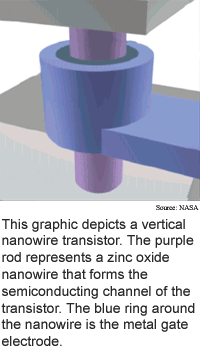
Nanowire makes standup transistor
Researchers from NASA Ames Research Center
have devised a simple way to make a set of vertical transistors from nanowires.
Vertical transistors can be packed more closely than traditional
horizontal configurations, and they can also be stacked into three-dimensional
arrays. The nanowires measure 40 nanometers in diameter and 1,000 nanometers
high. A nanometer is one millionth of a millimeter, or the span of 10
hydrogen atoms.
The densely-packed nanowire transistors could be used to make
fast, low-power computer chips and memory devices that hold a lot of data.
The nanowire serves as semiconductor channel that carries current
from a source electrode on the bottom of the vertical transistor to a
drain electrode on top. An electrode that surrounds the middle section
of the nanowire acts as a gate that controls the flow of current through
the device and so can turn it on or off.
The researchers grew the nanowire using a chemical vapor, encapsulated
it in a 20-nanometer insulating layer, deposited a 40-nanometer layer
of chromium to form the gate, ground the top to expose the nanowire, then
added the top electrode.
The researchers' device is made from zinc oxide nanowires, which
are appropriate for space applications because they are radiation resistant.
The key to using the researchers' method to make transistors for commercial
applications is to use silicon instead of zinc oxide.
The method could be used to make practical transistors in three
to five years, according to the researchers. The work appeared in the
July 14, 2004 issue of Nano Letters.
Fuel cell converts waste to power
Bank transfer demos quantum crypto
Agent model yields leadership
Flexible sensors make robot skin
Briefs:
Microscope etches ultrathin lines
Nanowire makes standup transistor
Plastics ease nanotube circuits
Virus forms nano template
Photo molecules flip current
Nanotubes on cloth fire electrons

Research Watch blog
View from the High Ground Q&A
How It Works
RSS Feeds:
News
Ad links:
Buy an ad link
Ad links: Clear History
Buy an ad link
|
TRN
Newswire and Headline Feeds for Web sites
|
© Copyright Technology Research News, LLC 2000-2010. All rights reserved.